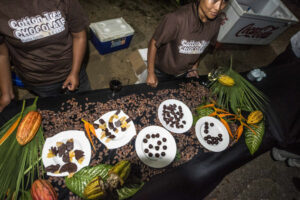 Photos by secretlondon123 & majcher on Flickr
Photos by secretlondon123 & majcher on Flickr
At the recent International Marine Conservation Congress held in Canada, experts discussed how the waters of Belize may soon be able to offer new opportunities for locals to make money. The topic being discussed by Julianne Robinson of The Nature Conservancy was seaweed mariculture.
Fishing has been an integral component of the Belizean economy for centuries. Even today, many locals in coastal communities of Belize depend on fishing both for their livelihoods and as a source of food. Climate change, overfishing, destructive fishing practices, and other factors have resulted in the recent decline in fisheries in Belize that many local communities depend on. As fisheries decline, local fishermen have been seeking new avenues of income.
Ms. Robinson spoke about how The Nature Conservancy has been working jointly with the Placencia Fishermen Cooperative in Belize in order to conduct pilot tests on mariculture farms. While many options are being currently explored, the most promising result so far has been growing red seaweed with the Latin name Euchemia isiforme.
See also: Belize Is An Angler’s Paradise
Growing seaweed is beneficial for a number of reasons. For one, the harvesting process is not dissimilar from fishing. Many of Belize’s local fishermen already include seaweed harvesting as a byproduct of fishing for queen conch and spiny lobster that like to cluster where seaweed grows. The collected seaweed is already being sold in local markets. Seaweed is used in Belize as a food item (including in the popular seaweed “shakes” drinks) but the challenge is to find additional uses for the seaweed such as a cooking thickener (similar to starch) or as an ingredient in soap making.
Growing seaweed has a number of benefits for the marine environment, including the restoration of nitrogen and phosphorous levels in the water. The seaweed also serves as a preferred habitat for the valuable queen conch and spiny lobster.
“We welcome this exciting development,” said Larry France, marketing manager of Chabil Mar. “We believe this is a really special opportunity to diversify income opportunities for traditional fishing communities while also helping to preserve fishing stocks, something that will benefit both tourists and locals alike.”
Local demand for red seaweed is high and expected to grow. Beyond the local economy, global demand for seaweed is increasing at about 10% per year, potentially opening lucrative and sustainable jobs for Belizean fishermen. The challenge moving forward will be to scale up production of the seaweed and to better develop overseas markets.











